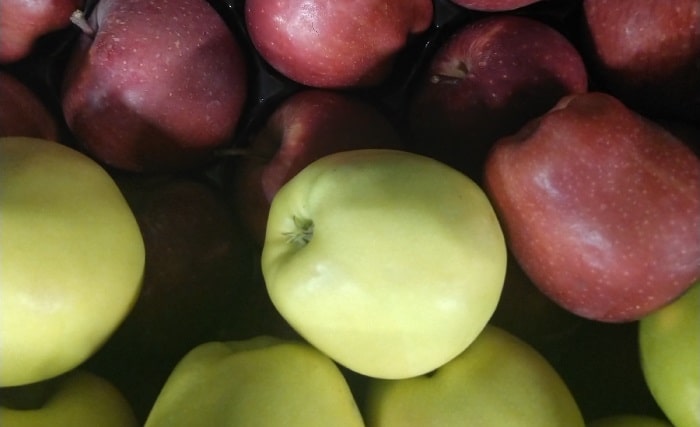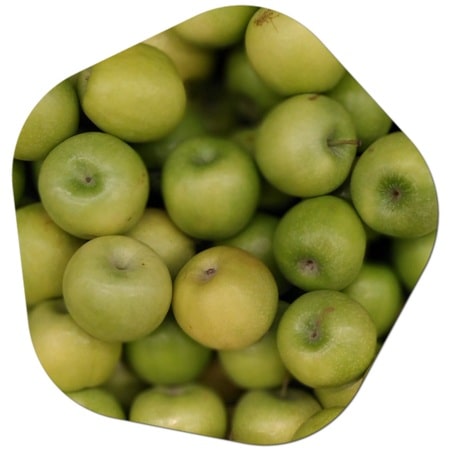Why do apples come in different Colours?
Apples of different colors grow due to genetic variations in their DNA code. Red, green and yellow apples belong to different apple varieties, resulting in different genetic codes that affect their taste. These genetic differences also lead to physical variations, contributing to the different flavors observed in apples. For example, green, red and yellow apples can have different flavors, and these variations are a result of genetic factors.
In general, the color of fruits, including apples, is influenced by pigments such as anthocyanins and carotenoids present in the skin or peel. These pigments can vary depending on the type of fruit, the specific fruit variety and the ripening process, and contribute to the variety of colors seen in apples. It is important to note that environmental factors, climate and growing conditions can also influence the development of color and flavors in apples

Apples come in different colors due to variations in pigments present in the fruit’s skin. The primary pigments responsible for the coloration of apples are anthocyanins, carotenoids, and chlorophyll.
- Anthocyanins: These are responsible for red, purple, and blue colors in many fruits, including some apple varieties. The presence and concentration of anthocyanins can be influenced by factors such as genetics, pH levels, and exposure to sunlight. Apples with a higher anthocyanin content will exhibit shades of red and purple.
- Carotenoids: Carotenoids contribute to the yellow and orange colors in apples. While red and green are more common apple colors, some varieties, especially those with yellow or greenish-yellow skin, have a higher concentration of carotenoids.
- Chlorophyll: Chlorophyll is the green pigment in plants responsible for photosynthesis. In apples, chlorophyll is present in varying amounts, depending on the stage of ripeness and exposure to sunlight. As apples ripen, the chlorophyll content decreases, allowing other pigments like anthocyanins and carotenoids to become more visible.
The combination and interaction of these pigments, along with genetic factors, determine the overall color of an apple. Different apple varieties exhibit a wide range of colors, from shades of red and green to yellow, and even a mix of multiple colors. The diversity in apple colors is not only visually appealing but also indicative of the different flavors and characteristics of various apple cultivars.
Why do apples appear red?
The red color of apples is primarily due to the presence of pigments called anthocyanins. Anthocyanins are a class of water-soluble pigments that belong to the flavonoid group. These pigments are responsible for the red, purple, and blue colors in many fruits, flowers, and leaves.

In apples, the concentration of anthocyanins varies among different varieties and can be influenced by genetic factors, environmental conditions, and ripeness. The production of anthocyanins in apple skin is often triggered by exposure to sunlight. Apples that receive more sunlight tend to develop a deeper red color.
It’s important to note that not all apple varieties have high levels of anthocyanins, and some apples are primarily green or yellow. The red coloration in apples is more pronounced in varieties such as Red Delicious, Fuji, and Gala, among others.
In addition to anthocyanins, carotenoid pigments (responsible for yellow and orange colors) and chlorophyll (responsible for green color) also contribute to the overall coloration of apples. As apples ripen, chlorophyll levels decrease, allowing the other pigments, particularly anthocyanins, to become more visible.
In summary, the red color of apples, like other fruit colors, is a result of the presence and interaction of various pigments, with anthocyanins playing a prominent role in giving apples their characteristic red hues.
Why do apples appear green?
The green color of apples is primarily due to the presence of chlorophyll, a green pigment involved in photosynthesis. Chlorophyll is crucial for plants as it allows them to capture sunlight and convert it into energy. Apples, like other green plants, contain chlorophyll in their cells.
In the case of apples, the green color is more evident when the fruit is unripe. As apples ripen, the chlorophyll content decreases, and other pigments become more visible. While chlorophyll gives apples their characteristic green color, other pigments such as carotenoids (yellow and orange pigments) and anthocyanins (red and purple pigments) may also be present in varying amounts.
Certain apple varieties are known for their predominantly green appearance even when fully ripe. Examples include Granny Smith apples, which are famous for their bright green skin. The specific genetics of each apple variety play a role in determining the distribution and concentration of pigments, influencing the overall color of the fruit.
In summary, the green color of apples is primarily due to the presence of chlorophyll. As apples ripen, changes in pigment concentrations occur, affecting the overall coloration of the fruit.
Why do apples appear white?
Apples don’t typically appear white; their most common colors are red, green, yellow, or a combination of these. However, if an apple appears white, it might be due to a waxy coating on its surface.
Apples naturally produce a layer of wax, often called the “bloom,” that helps protect the fruit and retain moisture. This waxy coating can sometimes give the apple a lighter or slightly whitish appearance. The bloom can be easily wiped off, revealing the true color of the apple skin underneath.
It’s also worth noting that certain apple varieties, like the “White Transparent” apple, are bred to have a more translucent or pale appearance. These apples are intentionally cultivated to have a light color, and they may have a mild, sweet taste.
If you encounter apples that seem unusually white, it’s a good idea to check if there’s an artificial wax coating or if they belong to a specific variety known for its paler skin. Additionally, freshness and storage conditions can impact the appearance of the apple, so purchasing apples from reputable sources can ensure you’re getting high-quality, naturally colored fruit. Why are apples red, green and white? >>





